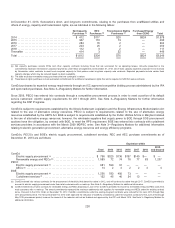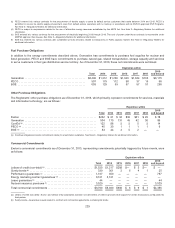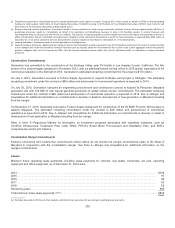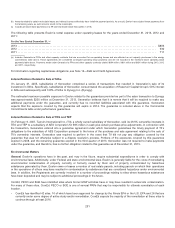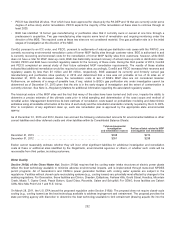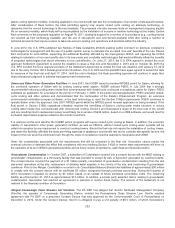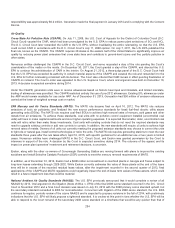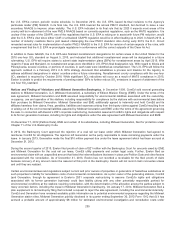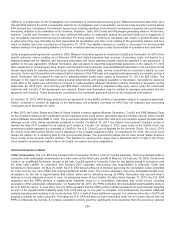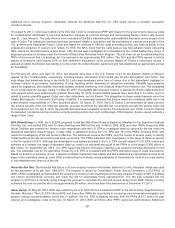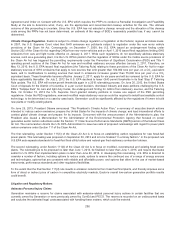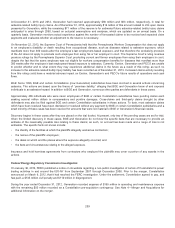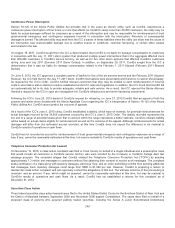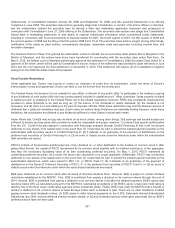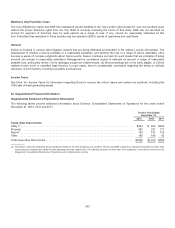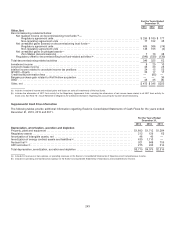ComEd 2013 Annual Report Download - page 239
Download and view the complete annual report
Please find page 239 of the 2013 ComEd annual report below. You can navigate through the pages in the report by either clicking on the pages listed below, or by using the keyword search tool below to find specific information within the annual report.plantscooling system) mortality, includingapplication ofacost-benefittestandtheconsideration ofanumber ofsite-specific factors.
After consideration ofthesefactors, thestate permittingagency mayrequire closed cycle cooling, an alternate technology, or
determine that thecurrent technology is thebestavailable.The proposedrule alsoimposeslimitson impingement (trappingaquatic
lifeonscreens) mortality, which likelywill beaccomplishedbytheinstallation ofscreensor another technology at theintake.Exelon
filedcommentson the proposedregulation on August18, 2011,statingitssupport for a number ofitsprovisions(e.g., coolingtowers
not requiredasbesttechnology available,andtheuseofsite-specific andcostbenefit analysis) while also notinganumber of
technical provisionsthat require revision to takeinto account existingunit operationsandpracticeswithintheindustry.
InJune 2012,theU.S. EPApublishedtwoNoticesofData Availability (NODA)seekingpublic comment on alternate compliance
technologiesfor impingement andtheuseofapublic opinion surveyto calculate theso-called“non-use”benefitsofthe rule.Exelon
filedcommentsfor each NODA,supportingtheadditional flexibilityaffordedbytheimpingement NODA,andopposingtheNODA
relatingto calculation ofnon-usebenefitsdue to itsinaccurate andunreliable methodologiesthat wouldartificiallyinflate thebenefits
ofproposedtechnologiesthat wouldotherwise not becost-effective.OnJune 27, 2013,theU.S. EPAagreedto amendthecourt
approvedSettlement Agreement to extendthedeadline to issue a final rule untilNovember 4, 2013 andon October 30,2013 the
U.S. EPAinvokedtheforce majeure provision oftheSettlement Agreement to extendthefinal rule deadline untilJanuary14, 2014
due to the earlyOctober 2013 federal government shutdown.TheU.S. EPAandthe plaintiffs haveagainagreedto extendthedate
for issuanceofthefinal rule until April17, 2014. Untilthe rule is finalized, thestate permittingagencieswill continue to applytheir
best professional judgment to address impingement andentrainment.
Salem and Other Power Generation Facilities. InJune 2001,theNJDEP issueda renewed NPDES permitfor Salem, allowingfor
thecontinuedoperation ofSalemwithitsexistingcoolingwater system. NJDEP advised PSEG, inJuly2004that itstrongly
recommendedreducingcoolingwater intakeflowcommensurate withclosed-cycle coolingasacompliance option for Salem. PSEG
submittedan application for a renewal ofthe permitonFebruary1,2006. Inthe permit renewal application, PSEG analyzedclosed-
cycle coolingandother optionsanddemonstratedthat thecontinuation oftheEstuaryEnhancement Program, an extensive
environmental restoration programat Salem, is thebesttechnology to meet theSection 316(b) requirements. PSEG continuesto
operate Salemunder the approvedJune 2001 NPDES permitwhile theNPDES permit renewal application is beingreviewed. If the
final permitorSection 316(b) regulationsultimatelyrequiresthe retrofittingofSalem’s coolingwater intakestructure to reduce
coolingwater intakeflowcommensurate withclosed-cycle cooling, Exelon’s andGeneration’s share ofthe total costofthe retrofit
andanyresultinginterim replacement power wouldlikelybeinexcess of$430 million,basedon a 2006estimate,andwouldresult in
increaseddepreciation expense relatedto the retrofitinvestment.
Itis unknownatthis timewhether theNJDEP permit programs will require closed-cycle coolingat Salem. Inaddition,theeconomic
viabilityofGeneration’s other power generation facilities, aswell as CENG’s, without closed-cycle coolingwater systems will be
calledinto question by anyrequirement to constructcoolingtowers. Shouldthefinal rule not require theinstallation ofcoolingtowers,
andretaintheflexibilityaffordedthestate permittingagenciesin applyingacostbenefittestandto consider site-specific factors, the
impactofthe rule wouldbeminimizedeven though thecostsofcompliancecouldbematerial to Generation and CENG.
Given theuncertaintiesassociatedwiththerequirementsthat will becontainedinthefinal rule,Generation cannot predictthe
eventual outcomeorestimate theeffectthat compliancewithanyresultingSection 316(b) or interim state requirementswill haveon
the operation ofitsand CENG’s generatingfacilitiesanditsfuture resultsofoperations, cash flows andfinancial position.
Groundwater Contamination. InOctober 2007, asubsidiaryofConstellation enteredinto a consent decree withtheMDE relatingto
groundwater contamination at a third-partyfacilitythat waslicensedto accept flyash, abyproductgeneratedbycoal-firedplants.
Theconsent decree requiredthepayment ofa$1million penalty, remediation ofgroundwater contamination resultingfromtheash
placement operationsat thesite,replacement ofdrinkingwater suppliesinthevicinityofthesite,andmonitoringofgroundwater
conditions. Prior to theMerger,Constellation recordedinitsConsolidatedBalanceSheetstotal liabilitiesofapproximately$30 million
to complywiththeconsent decree withan additional $3million recognizedthrough purchaseaccounting. Duringthirdquarter of
2013,Generation increaseditsreserveby $2million basedon an update offuture estimatedremediation costs. Theremaining
liabilityasofDecember 31,2013,isapproximately$14million.Inaddition,aprivate partyassertedclaims relatingto groundwater
contamination.Generation hasreachedan agreement inprinciple to resolvetheseclaims. Theamount ofthesettlement is not
material to thefinancial condition ofGeneration.
Alleged Conemaugh Clean Streams Act Violation. ThePADEP hasallegedthat GenOnNortheastManagement Company
(GenOn), the operator ofConemaugh GeneratingStation,violatedthePennsylvaniaClean Streams Law. GenOn reached
agreement withPADEP on a proposedConsent Decree that wasapprovedbytheCommonwealthCourt ofPennsylvaniaon
December 4, 2012.Under theConsent Decree,GenOnis obligatedto payacivil penaltyof$0.5 million,of which Generation’s
233







